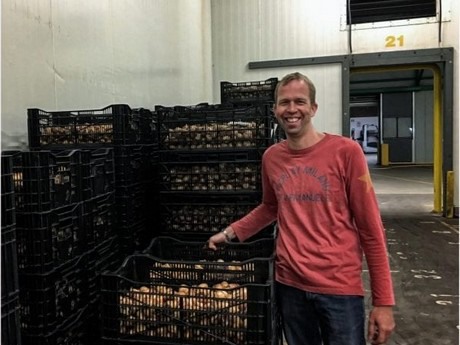There are rules for the proper storage of flower bulbs. Joost Bakker of Van Zanten Flowerbulbs knows this like no other. 17 years ago he arrived at Royal Van Zanten and over the course of time he started to focus on the storage and preparation of flower bulbs. He is now responsible for millions of flower bulbs every year.
His responsibility starts with the storage of flower bulbs in the cold stores. From entry to departure. Joost: “Although these cold stores are computer controlled, it is and remains human work, a ‘skill’ that I have developed over the years.” But how does it work in practice? A look into the world of: storage and preparation of flower bulbs. Let’s start with the summer bulbs (tulips and more).
Physical rounds
Twice a day, seven days a week, Joost and his colleagues take physical rounds through each cold store. In addition to checking and recording temperature and humidity, controls also take place on the ethylene level in the air. A high ethylene level can indicate sick bulbs in the cold stores. As soon as this is detected, the batch of bulbs is immediately put into quarantine.

Joost in one of the cold stores of Van Zanten Flowerbulbs in the Netherlands
External factors
Besides physical rounds, there are also external factors that have to take into account when controlling the cold store. For example, wind speed, temperature and air humidity. These external factors influence the climate inside the cold store. What is very important is that bulbs don’t get ‘stressed’. To prevent this, ensure a constant storage temperature without fluctuations. The temperature is gradually adjusted during the season. A second important point is: do not perform too many actions with the bulb at the start of the season. This too can cause ‘stress’. It is best to keep this purely to the basics. And move the remaining actions to the end of the season.
Air
What should not be forgotten is: fresh air. Fresh air is very important in the cold stores, this is controlled via valves. Joost: “Too much fresh air in the cold stores causes the bulbs to dry out. If there is too little fresh air, too much ethylene can form in the cold stores, which means that ethylene damage can occur. In summary, regulating fresh air through the valves is very important and secure.” This year Royal Van Zanten will analyze the ethylene in the cell with a “gas analyzer”. All these values are measured, analyzed and collected centrally. Based on this data, they can adjust and take action. In addition, the ventilation valves in the cold store are also controlled using this “gas analyzer”.
Development stage
Different temperatures are used in the storage of tulip bulbs. Before the flower development starts, the bulbs have to be stored at a constant warm temperature. When setting the correct temperature, the development stage of the flower inside the bulb must always be determined first. There are six different stages, stage: I, II, P1, A1, A2 and G. Joost: “Because only with this information you can determine the correct temperature and duration in the cold store.”
For more information: Royal Van Zanten
Royal Van Zanten
Lavendelweg 15, Rijsenhout
P.O. Box 265, 1430 AG Aalsmeer
The Netherlands
Tel: +31(0)297 38 70 00
www.royalvanzanten.com
